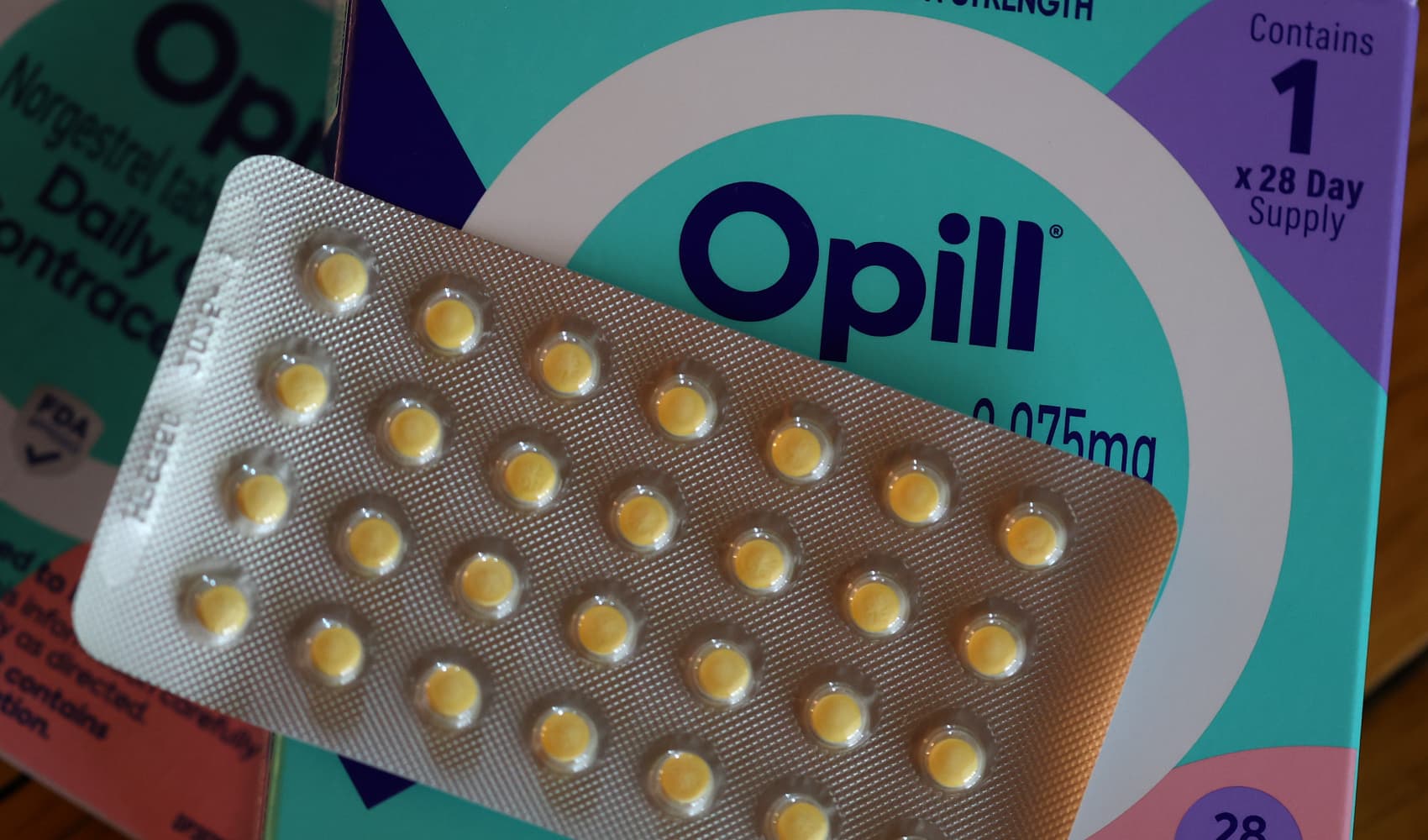
Every morning for a year and a half, Logan Whitehead, 24, rubbed a clear gel on his shoulders, waited for it to dry, then went about his day as usual.
“It was basically like a hand sanitizer solution,” Whitehead shared with NBC News, who lives in Torrance, California. “Smelled like hand sanitizer, looked like hand sanitizer.”
Watch NBC6 free wherever you are
The gel wasn’t hand sanitizer, though. It was a hormonal solution meant to block Whitehead’s sperm production. The gel was male birth control.
Until this past winter when his participation concluded, Whitehead was a volunteer in a phase 2 trial for the gel. The product — which contains testosterone and a synthetic hormone called Nestorone that reduces sperm production — is the most advanced among a crop of novel birth control options for men.
Get local news you need to know to start your day with NBC 6's News Headlines newsletter.
If the Food and Drug Administration approves the gel, Whitehead said he would definitely keep using it, especially after watching his partner struggle with available female birth control options.
“The gel was such an easy process,” he said. “It was basically like taking the pill for the day.”
Whitehead said he didn’t notice side effects using the gel beyond some upper back acne and possibly a bit of weight gain, although that could have been linked to a new sedentary job.
Hormonal gel trial shows promise
On Sunday, at the Endocrine Society’s conference in Boston, researchers with the National Institutes of Health’s Contraceptive Development Program presented encouraging phase 2 trial results on the hormonal gel.
The trial involved 222 men, ages 18 to 50, who applied 5 milliliters of the gel (about a teaspoon) to each of their shoulder blades once per day.
The second part of the two-part trial is still underway. Initial findings showed that the contraceptive worked faster than expected, according to Diana Blithe, chief of NIH’s Contraceptive Development Program.
After 12 weeks of applying the gel every day, 86% of trial participants achieved sperm suppression, meaning they had only up to 1 million sperm per milliliter of semen, the amount the researchers deemed effective for contraception. On average, the timing for effective contraception was eight weeks.
In comparison, normal sperm counts without contraception can range from 15 million to 200 million per milliliter.
The faster-than-expected timing to suppress sperm is an encouraging sign, especially since past attempts have taken longer to reach these sperm levels, Blithe said in a news release about the new data.
Prior efforts using testosterone alone have required higher doses of the hormone, which can cause side effects. Because the gel includes both testosterone and Nestorone, it acts more quickly and requires less testosterone, she said.
Nestorone is a type of synthetic hormone called a progestin that’s already used in the vaginal ring contraceptive. Combining Nestorone and testosterone in the new gel is meant to keep men from producing sperm without affecting their sex drive or causing other side effects.
So far, the men in the gel clinical trial have shown low enough blood levels of testosterone to maintain their normal sexual function.
Researchers are now tracking how well the gel works to prevent pregnancy. Because of pregnancy risk, male participants are required to be in committed, monogamous relationships, and need consent from their female partners too. The couple must agree to use the gel as their only birth control and to have sex at least once a month for a year. Throughout the study, men have their sperm counts tested periodically, which is a good predictor of fertility. If the sperm counts remain low, the chances of pregnancy are slim.
After decades of early-stage attempts and failures, there are no federally approved male birth control drugs. Only a handful have even advanced into human trials.
It’s not because the approaches haven’t shown potential, researchers say, but because there hasn’t been enough funding or financial investment to complete expensive advanced human trials.
“We’ve been pushing for hormonal male contraceptives for 50 years, but there isn’t enough money available to really drive something through a very large phase 3 trial,” said Daniel Johnston, chief of the National Institute of Child Health and Human Development’s Contraception Research Branch.
If one male birth control drug gains approval from the FDA, pharmaceutical companies and industry investors would put more resources into other medications or products, Johnston believes.
“We’ve been chasing this for a long time,” Johnston said. “I hope we’re entering new territory.”
Nonhormonal options in development
Also at the Boston conference on Sunday, YourChoice Therapeutics said a very small trial in the U.K. — just 16 men — showed that its nonhormonal pill, YCT-529, was safe and free of side effects. The San Francisco company’s nonhormonal pill works by blocking the vitamin A receptor important for male fertility.
YourChoice is planning a larger trial, according to CEO Akash Bakshi.
“We’re excited to see what happens next,” Bakshi said.
Separately, a Charlottesville, Virginia, medical device company, Contraline, is developing a nonhormonal male birth control method that involves injecting a gel into the vas deferens, the tubes that transport sperm from the testicles.
Injecting the gel, called ADAM, involves a single, 15-minute procedure, said Kevin Eisenfrats, Contraline’s CEO and co-founder. Then, the gel is meant to stay in place for years. Contraline compares the long-acting reversible contraceptive to an intrauterine device (IUD) for women.
Contraline has been testing ADAM in an early clinical trial in Australia. In January, the company reported that among 25 clinical trial participants, the approach resulted in a 99.8% to 100% reduction in the number of motile sperm within 30 days of the procedure, Eisenfrats said.
“It’s honestly very similar to the experience patients have after a vasectomy,” he said. “Some of these patients had light bruising and swelling, which go away on their own.”
Contraline hopes to start testing ADAM in the U.S. in 2025.
Because Contraline is developing ADAM as a medical device and not a drug, it may be able to go through a speedier clinical trial and regulatory process than contraceptive drugs like the hormonal gel, experts suggest.
If it goes according to plan — which can be rare for novel products with no precedent — Eisenfrats said he’s aiming for an FDA approval in 2027.
Another company called Next Life Sciences is developing a similar method. Next Life’s approach, called Plan A, or Vasalgel, also involves blocking the vas deferens with a gel-like injection. Next Life is based in Flagstaff, Arizona. Next Life hasn’t started testing Plan A in people yet, although the company did test its method of injecting the gel in Canadian volunteers this past year.
Demand for new contraception is growing
U.S. and global surveys have found that men are willing to use contraception, said gynecologist Dr. Brian Nguyen, one of the investigators on the gel clinical trials.
“By and large, they always say they’d be interested,” said Nguyen, an associate professor of obstetrics and gynecology at the University of Southern California.
According to one 2023 survey published in the journal Contraception, three-quarters of 2,066 male respondents said they’d be willing to use new contraceptives.
In 2019, the nonprofit Male Contraceptive Initiative estimated more than 17 million men in the U.S. want more birth control options.
Heather Vahdat, the Male Contraceptive Initiative’s executive director, said interest in male birth control has been on the rise since the Supreme Court overturned Roe v. Wade in 2022.
Recent research from the University of Pittsburgh School of Public Health found that the number of young women and men choosing permanent birth control such as vasectomy and tubal ligation increased sharply after the court’s decision and has continued to rise.
A separate study conducted in part by the Male Contraceptive Initiative, showed that before the abortion ruling, 78% of men in the U.S. said they were interested in trying new birth control methods. Afterward, it climbed to 82%.
“The demand has always been there, but there’s a greater intensity now,” Vahdat said. “We get emails daily from people asking where they can sign up for clinical trials.”
Unlike a vasectomy, each of the new contraceptive approaches is meant to be reversible, so men can stop using them and regain their ability to have children.
“Vasectomies are a great solution for men who are done having kids,” Eisenfrats said. But reversing the procedure — which involves reattaching the vas deferens in a three-hour microsurgery — can be extremely challenging and doesn’t always work, he said.
While condoms can be highly effective against pregnancy or sexually transmitted infections when used perfectly, perfect use is hard to achieve. And condoms generally aren’t the preferred contraceptive in long-term relationships, YourChoice’s Bakshi said.
Why is male birth control taking so long?
The new trial results are encouraging to Vahdat. But she knows that it’s not enough to show a birth control method is safe and effective. The product needs substantial buy-in from investors, too.
“We have this classic line, ‘Male contraceptives have been 10 years away for 50 years,’” Vahdat said.
The reason, she believes, boils down to lack of funding.
After NIH research grants, the Male Contraceptive Initiative is the second-biggest funder of male contraceptive research in the world, according to Vahdat.
“That’s super exciting, except when you consider we only grant about $1.5 million a year,” she said.
On average, the Congressional Budget Office ballparks $1 billion to $2 billion as the amount needed to take a drug through clinical trials and onto the market.
Right now, there’s just not enough money to take any of these male birth control approaches through the FDA review process, USC’s Nguyen said.
The hormonal gel is the most advanced in clinical trials, but it still hasn’t gone through a much larger, lengthy phase 3 trial. As of now — in part due to funding uncertainties — plans to test the gel further are still up in the air.
Most academic researchers or small biotech companies developing new drugs rely on drugmakers with deep pockets to fund advanced trials. In exchange, these bigger companies usually expect a cut of profit once the drugs make it to market.
The studies so far have been funded by NIH and the independent nonprofit Lundquist Institute in Torrance, California.
As of now, Nguyen said, there’s no major pharmaceutical company stepping in to fund the male contraceptive gel’s next-stage trials.
“There has to be an industry partner,” he said.
Nguyen thinks the challenge is that despite evidence that men want options, many couples still depend on female birth control.
“But that doesn’t mean they are satisfied with them and wouldn’t appreciate a male method.” Nguyen said.
“People always ask, ‘How long will it be until we see this product on the market?’” Nguyen said. “Most people will say five to 10 years, but I disagree.”
However, the chance of any of these male contraceptives — the gel, the physical blockers, the pills and whichever new methods crop up next — making it to market depends on whether investors with deep pockets recognize the demand is really there, Vahdat said.
To reach this point, she believes, the conversation has to shift away from viewing male contraception and female contraception as mutually exclusive landscapes with two separate populations demanding them.
“I think of male contraception as women’s health,” she said. “You’re still preventing unintended pregnancy.”
This story first appeared on NBCNews.com. More from NBC News:




